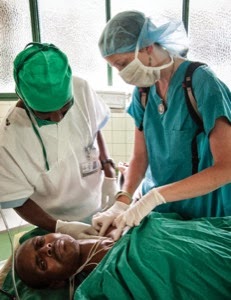 |
| Typical OR in Rwanda. |
But this wasn’t Europe or North America. It was Rwanda. It took the patient three days to get to the hospital because she lived so far away. And there was no fiber-optic endoscope to perform intubation and to examine her vocal cords. The hospital did not even have a range of anesthetics at hand—only halothane.
This summer, Marcel Durieux, MD, PhD, and a group of anesthesia residents at the University of Virginia (UVA) sat quietly around a rectangular table in a windowless conference room, listening to anesthesia residents in Rwanda describe the patient—part of a new program in which residents on either side of the globe schedule monthly teleconferences to consult on difficult cases.
The program, which began about eight months ago, helps both groups of doctors, said Dr. Durieux, professor of
anesthesiology at UVA,
in Charlottesville. Medical residents in the United States learn
creative ways to deal with cases without the latest tools of modern
medicine, and Rwandan residents obtain additional training.
“The whole country has 11 anesthesiologists, and it’s just not enough to train more residents,” Dr. Durieux told Anesthesiology News.
“It’s difficult for us to understand how isolated physicians in
developing countries tend to work. You may not have Internet access; you
cannot go to conferences; you cannot subscribe to journals.”
Residents in the United States, on the other hand, constantly are
learning from cases and encountering new tools and practices. “Anything
we can do to break that isolation [Rwandan doctors face], to exchange
ideas and discuss complex cases, both sides will learn from,” Dr.
Durieux said.
Although the UVA telemedicine program performs distance medicine for
rural Virginia and other locations, Dr. Durieux said it is the first
anesthesiology telemedicine program for Africa. The group patterned it
after a similar program set up by UVA surgeons.
Alternating Perspectives
During the calls, both
sides take turns. One month, Rwandan doctors present a case; the
following month, it’s the U.S. residents’ turn. They try to pick cases
that might happen in Rwanda and include technology the doctors might one
day have access to. For instance, earlier this year, the American team
described a closed head injury they managed using an arterial line, IVs
and a computed tomography scan. Clinicians reviewed how they dealt with a
patient experiencing increased intracranial pressure, indicating
bleeding inside the brain. “They may not be able to do all this now, but
at least it gets them thinking about what they would do if more money
becomes available, and their system gets upgraded,” Dr. Durieux said.
But international residents have a few resources doctors here don’t,
noted Jennifer O’Flaherty, MD, MPH, associate professor of
anesthesiology and pediatrics at Dartmouth-Hitchcock Medical Center, in
Lebanon, N.H. For instance, many other countries have IV tramadol and IV
acetaminophen, which are rare in the United States. “I don’t know of
any similar programs” that enable anesthesiologists from other countries
to discuss cases they managed with local resources, added Dr.
O’Flaherty, who is not involved in the telemedicine effort but works
with Dr. Durieux on a separate project to boost Rwanda’s capacity to
train residents, including in anesthesiology (http://hrhconsortium.moh.gov.rw/).
Indeed, although learning about new technologies and treatment
options is helpful, the real benefit of the meeting comes from
revisiting previous cases and decisions, said Julia Weinkauf, MD, a
faculty member in the Department of Anesthesiology in the UVA Health
System, who helped set up the telemedicine program. “The experience of
verbalizing and even defending your rationale for a certain treatment
plan is very valuable for any trainee, and the Rwandan residents don’t
get this opportunity in many other areas of their training,” Dr.
Weinkauf told Anesthesiology News.
Rwandan students have plenty of printed materials to learn from,
added Dr. Weinkauf, who also is on the faculty of the Department of
Anesthesia in the University Central Hospital of Kigali, in Rwanda. When
international doctors and teachers give lectures and workshops, they
frequently leave behind PowerPoint files, books, articles and other
resources. “But what they need most is guidance and mentoring on how to
become adult learners and mature, critically thinking, academic
physicians,” she said.
But those are skills that every doctor needs to cultivate, so the Rwandan residents try to present cases they know their U.S. colleagues will benefit from, as well, Dr. Weinkauf said. The wounded trachea case, for instance: “Such a case is very infrequently seen in the United States, so it provoked some interesting discussion.”
Indeed, the U.S. residents asked many questions about the patient with the tracheal injury. “Each conference is scheduled for one hour, but in reality every single one has run over because there’s too much to talk about,” Dr. Durieux said. Would it be safe to attempt intubating the patient, or should she undergo an awake tracheostomy? What vascular access did you have? What fluids and blood products would you want to have available? In the end, the patient did have a tracheostomy, and was found to have esophageal damage as well. Fortunately, she survived.
SCROLL DOWN TO LEAVE A COMMENT










No comments:
Post a Comment